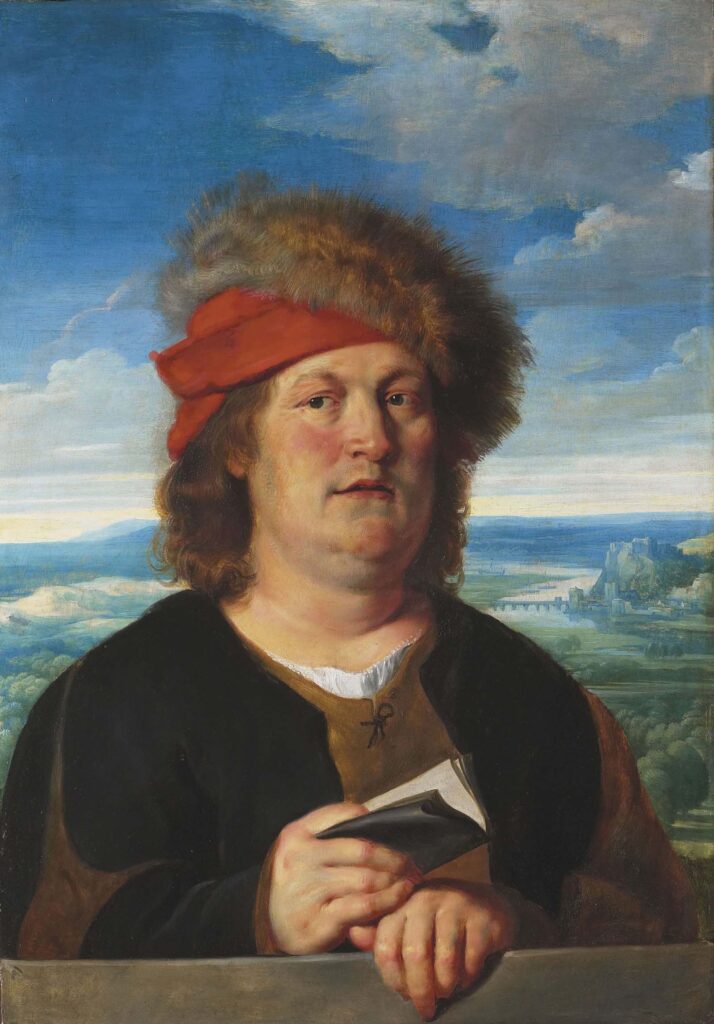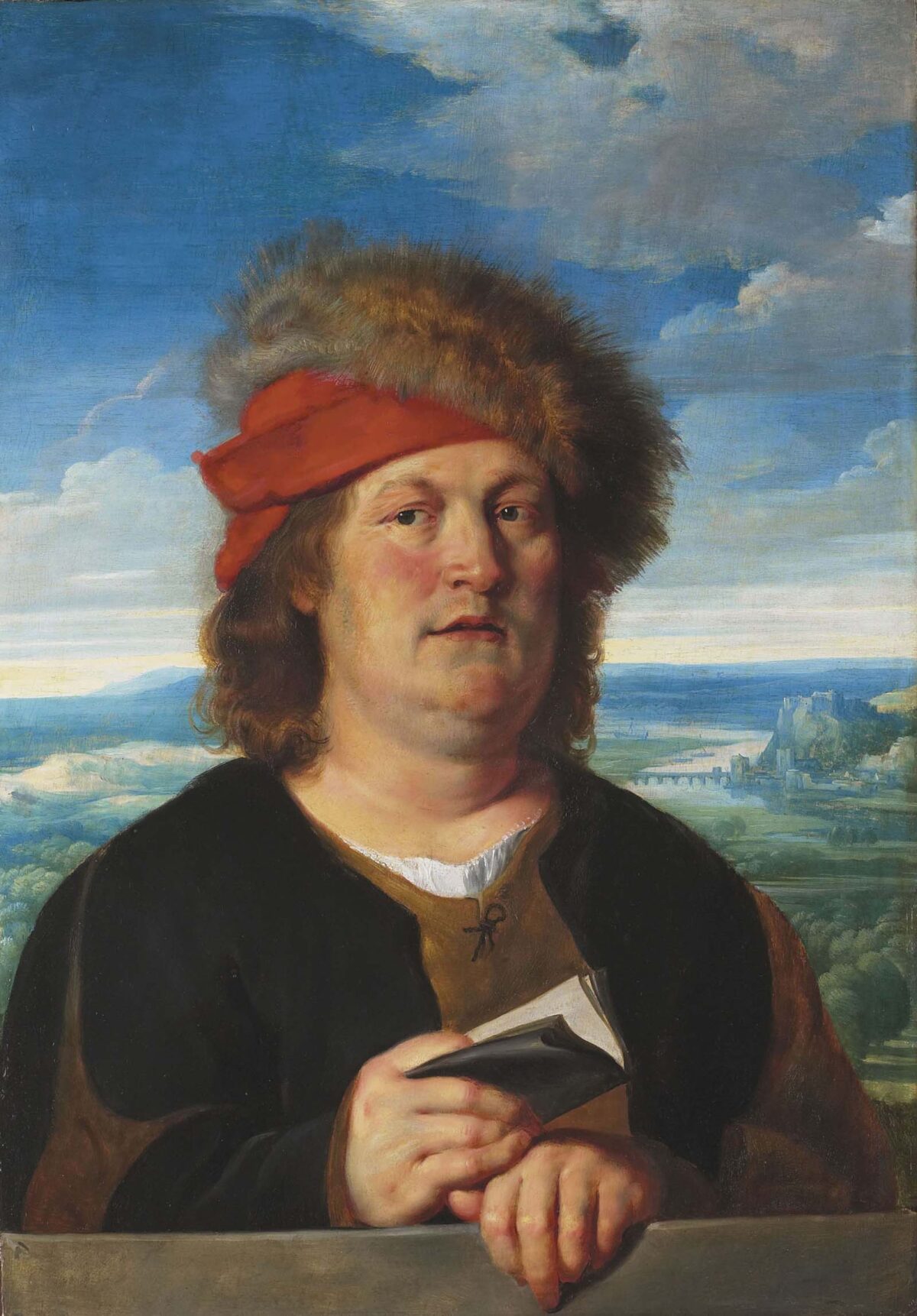
Peter Paul Rubens, Portrait of Paracelsus, ca. 1615-1620, oil on panel, 77.5 x 54.5 cm. Brussels, Royal Museum of Fine Arts, inv. 3425.
Executed by Rubens between 1615 and 1620, the Portrait of Paracelsus shows the famous Swiss physician and alchemist facing a parapet and clutching a half-open booklet between the fingers of one hand, while behind him a river landscape of green and blue hues opens to view. The sitter has a plump, drooping face, with a well-highlighted double chin framed by long brown hair flowing down his neck. For his physiognomy and the overall composition Rubens drew inspiration from an early 16th-century Flemish prototype.[1] Possibly his desire to rival the art of the great painters of the Netherlandish tradition made him prefer this likeness of Paracelsus to the one known through 16th-century portrait engravings. In the latter, in fact, commissioned by Paracelsus himself to adorn the frontispieces of his books, the doctor’s physiognomy, with a bald head and angular face, is different from that copied by Rubens to pay homage to the northern painting tradition of the past.[2]
However, Rubens’ version is not just an exercise in artistic emulation and civic pride; rather, it represents a tangible evidence of the master’s fascination with Paracelsian alchemy and the immense popularity this discipline enjoyed in early 17th-century Antwerp. In this city, distinguished men of the merchant class and members of religious orders engaged in the transmutation of metals and the art of distillation, sometimes exploring their possible therapeutic applications in the treatment of disease. Alchemy thus assumed a foundational knowledge value with ramifications that extended far beyond the vain search for gold to include the investigation of the natural world, the production of balsams, the extraction of quintessences, the art of glassmaking and enameling, the manufacture of oils and synthetic pigments.[3] Beyond the variety of its practical implications, alchemy was also a theory-driven discipline and an integral part of natural philosophy; indeed, Paracelsus’ ars spagiria was not separated from cosmological, anthropological, and theological elements that attracted the attention of a growing number of devotees and critics. Among the enthusiasts, Rubens was soon captivated by the doctrine of the controversial and revolutionary alchemist: the analogy between human and divine making, between Nature’s generative work and artistic creation, central to Paracelsus’s thought, must have exerted a great fascination on the young painter.[4] Later, away from prying eyes, Rubens would refer to the Paracelsian tria prima (Mercurius, Salt or water, and Sulphur) from which all things, including the human figure, are generated, as he developed his original art-theoretical musings in a notebook.[5] His speculative efforts were aimed at exploring, through the search for concordances between Paracelsian alchemy, Cabala, Pythagorean numerology, and Hermetism, the philosophical and theological foundations of the human figure, its origin and its form determined by a “predestined” quintessence. Elsewhere, his reference to the famous Tabula Smaragdina, which describes the conjunction of the male sun and female moon aimed at the generation of the child and the restoration of the lost unity, demonstrated his familiarity with alchemical literature.[6] Indeed, the metaphor of gestation described there alluded to the alchemical process, which through the union of sulfur and mercury leads to the attainment of the Philosopher’s stone.
For Rubens, therefore, alchemy had a very close relationship with philosophy and distanced itself from the false and vain search for the “sophistic gold.” Rather, for the painter, alchemy and its processes revealed secrets of the natural world and the principles of generation. A connoisseur of the “art that most closely imitates nature,”[7] Rubens infused life and spirit into his figures through the judicious use of mixtures and the contrast of light and shadow. Like a spagyrist imitating Nature’s creative agency, he transformed and vivified formless matter with brush and color, imprinting the divine “sign” into his art.
Probably intended for his private collection, the Portrait of Paracelsus was copied by Rubens to celebrate an energetic awareness of himself, of his art, and of his being in continuity with the golden age of Flemish painting.
Teresa Esposito (2023)
Literatur
Larry Silver, The Paintings of Quinten Massys: with Catalogue Raisonné, Montclair, NJ: Allanheld and Schram, 1984, p. 242; Ingonda Hannesschläger, “Echte und vermeintliche Porträts des Paracelsus”, in: Paracelsus und Salzburg. Vorträge bei den Internationalen Kongressen in Salzburg und Badgastein anläßlich des Paracelsus-Jahres 1993, eds. Heinz Dopsch and Peter F. Kramml, Salzburg 1994 (Mitteilungen der Gesellschaft für Salzburger Landeskunde, 14. Ergänzungsbd.), 1994, p. 230-234, figs. 20, 21; Tine Meganck, “Rubens on the Human Figure: Theory, Practice and Metaphysics”, in: Rubens: A Genius at Work. The Works of Peter Paul Rubens in the Royal Museums of Fine Arts of Belgium Reconsidered, Exhibition from 14 September 2007 until 27 January 2008 (KMSKB, Brussels), eds. Joost Vander Auwera and Sabine van Sprang, Tielt: Lannoo, 2007, p. 78-81, cat. nos. 7-8; Kristin Lohse Belkin, Copies and Adaptations from Renaissance and Later Artists. I. German and Netherlandish Artists, CRLB XXVI, vol. 1, London, 2009, p. 234-238, cat. 119; vol. 2, figs. 329-330; Tine Meganck, in: Kunst und Alchemie, Munich: Hirmer, 2014, p. 146-149, fig. 3; Kirk Nickel, in: Early Rubens, Exhibition from 6 April to 2 September 2019 (Fine Arts Museums of San Francisco [California]), and from 12 October 2019 to 5 January 2020 (Art Gallery of Toronto [Ontario]), eds. Sasha Suda and Kirk Nickel, Munich: DelMonico Books-Prestel, 2019, p. 138-139.
On Rubens’ Theoretical notebook and its manuscript copies (Ms. Chatsworth; Ms. Bordes; Ms. Johnson; Ms. de Ganay), see
Arnout Balis, “Rubens und Inventio. Der Beitrag seines theoretischen Studienbuches”, in: Rubens Passioni. Kultur der Leidenschaften im Barock, ed. Ulrich Heinen et al., Göttingen: Vandenhoeck & Ruprecht, 2001, p. 11-40; Rubens, Théorie de la figure humaine, ed. Nadeije Laneyrie-Dagen, Paris: Éditions Rue d’Ulm, 2003, p. 9-45; David Jaffé with Amanda Bradley, “Rubens’s ‘Pocketbook’: An Introduction to the Creative Process”, in: Rubens. A Master in the Making. Exhibition from 26 October 2005 until 15 January 2006 (The National Gallery, London), ed. David Jaffé et al., London, The National Gallery, 2005, p. 21-28; Meganck 2007, p. 52-64; David Jaffé, “Rubens’s lost ‘pocketbook’: some new thoughts”, The Burlington Magazine 152, 2010, p. 94-98; Teresa Esposito, Black Ethiopians and the origin of ‘materia prima’ in Rubens’ images of Creation, in: Oud Holland – Journal for Art of the Low Countries, Rom 2020, S. 10-32; Teresa Esposito, Rubens’s encounter with natural philosophy and the ‘occult sciences’ in 17th century Italy, in: Rubens e la cultura italiana nella prima metà del XVII secolo, hg. von C. Paolini and R. Morselli, 2020, S. 233-246>; Berit Wagner, “Kunsttheorie zwischen Hermetismus und Naturmagie, oder: Warum das theoretische Studienbuch des Peter Paul Rubens im Verborgenen blieb”, in: Vom Wort zur Kunst: Künstlerzeugnisse vom frühen Mittelalter bis zur Gegenwart, ed. Helen Barr et al., Emsdetten: Edition Imorde, 2020, p. 135-168>; Arnout Balis, in: Peter Paul Rubens: Becoming Famous. Exhibition from 22 October 2021 until 20 February 2022 (Staatsgalerie Stuttgart, Stuttgart), ed. Nils Büttner et al., Dresden: Sandstein Verlag, 2021, p. 157-165; Teresa Esposito, Peter Paul Rubens and the Distribution of Secret Knowledge in Antwerp and Italy, Dissertation Ghent University 2018, Publikation in Vorbereitung (Brepols Publishers)
Endnoten
[1] Most scholars believe that Rubens copied the portrait of Paracelsus by Quinten Metsys (1465/66-1530), founder of the Antwerp school of painting; others have proposed the prototype was executed by an artist close to the Antwerp circle of Joos van Cleve (1485/90-1540/41), see Silver 1984, p. 242; Hannesschläger 1994, p. 230-234, figs. 20, 21; Meganck 2007, p. 78-81, cat. nos. 7-8; Lohse Belkin 2009, p. 234-238, cat. 119; vol. 2, figs. 329-330; Meganck 2014, p. 146-149, fig. 3; Nickel 2019, p. 138-139.
[2] Hannesschläger 1994, p. 219, 223, 224, 226.
[3] For instance, the Portuguese merchant Emmanuel Ximenez (1564-1632) mainly practiced the branch of alchemy known as chematria, intended for the production of drugs, see Lawrence Principe, “The Laboratory,” in Dupré – Göttler, eds., Reading the Inventory, http://ximenez.unibe.ch; otherwise, the Jesuit and mathematician Franciscus Aguilonius (1566-1617), with whom Rubens collaborated, carried out experiments in chrysopoeia (i.e., the transmutation of metals), see Georgiana Delia Hedesan, “The Influence of Louvain Teaching on Jan Baptist Van Helmont’s Adoption of Paracelsianism and Alchemy”, Ambix 68, 2021, p. 241-242.
[4] On Rubens’ initiation into Paracelsus’ teachings, see Teresa Esposito, Rubens and Modern Science. Mastering Natural Philosophy in 17th Century Europe, forthcoming.
[5] After Rubens, Ms. Bordes, Madrid, Biblioteca del Museo Nacional del Prado, fol. 28v; After Rubens, Ms. de Ganay, Antwerp, on loan to the Rubens House, fol. 10. On Rubens’ Theoretical notebook and its manuscript copies (Ms. Chatsworth; Ms. Bordes; Ms. Johnson; Ms. de Ganay), see Balis 2001, p. 11-40; Nadeije Laneyrie-Dagen 2003, p. 9-45; Jaffé with Amanda Bradley 2005, p. 21-28; Meganck 2007, p. 52-64; Jaffé 2010, p. 94-98; Wagner 2020; Balis 2021, p. 157-165.
[6] After Rubens, Ms. Bordes, fol. 47r.
[7] Albertus Magnus, De mineralibus, III, 1, 2, ed. Auguste Borgnet, B. Alberti Magni Opera omnia, V, Paris, 1890, p. 61b.
